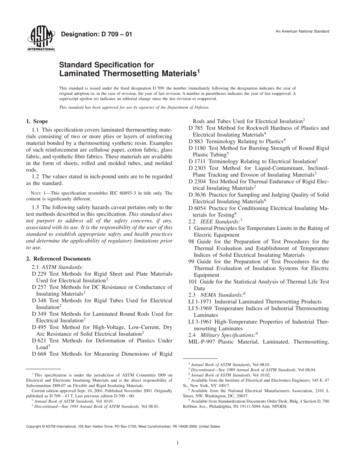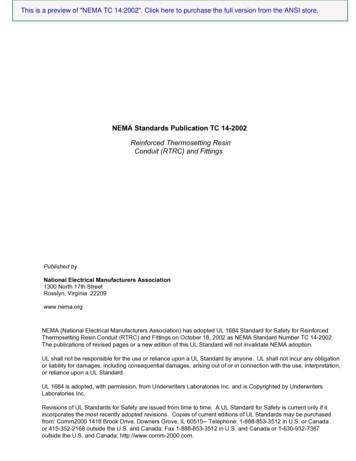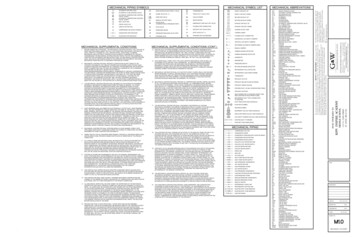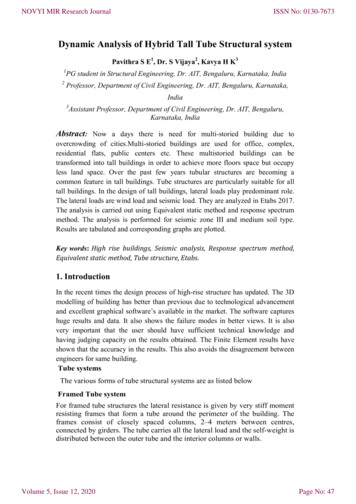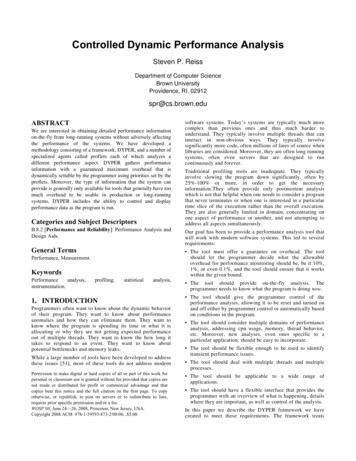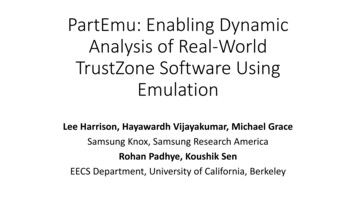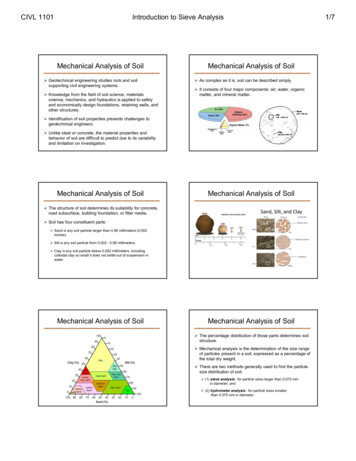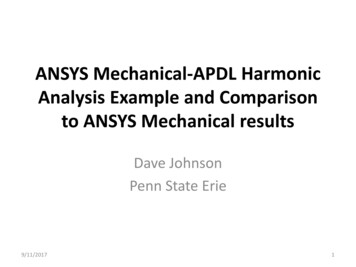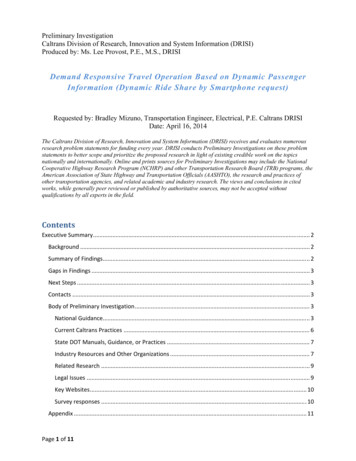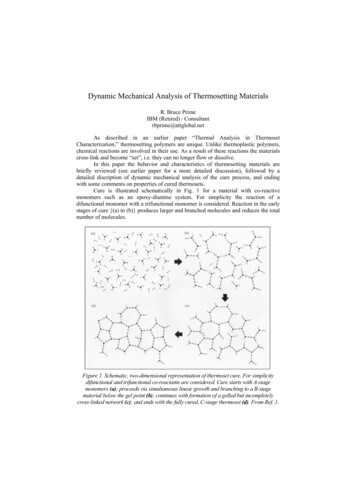
Transcription
Dynamic Mechanical Analysis of Thermosetting MaterialsR. Bruce PrimeIBM (Retired) / Consultantrbprime@attglobal.netAs described in an earlier paper “Thermal Analysis in ThermosetCharacterization,” thermosetting polymers are unique. Unlike thermoplastic polymers,chemical reactions are involved in their use. As a result of these reactions the materialscross-link and become “set”, i.e. they can no longer flow or dissolve.In this paper the behavior and characteristics of thermosetting materials arebriefly reviewed (see earlier paper for a more detailed discussion), followed by adetailed discription of dynamic mechanical analysis of the cure process, and endingwith some comments on properties of cured thermosets.Cure is illustrated schematically in Fig. 1 for a material with co-reactivemonomers such as an epoxy-diamine system. For simplicity the reaction of adifunctional monomer with a trifunctional monomer is considered. Reaction in the earlystages of cure {(a) to (b)} produces larger and branched molecules and reduces the totalnumber of molecules.Figure 1. Schematic, two-dimensional representation of thermoset cure. For simplicitydifunctional and trifunctional co-reactants are considered. Cure starts with A-stagemonomers (a); proceeds via simultaneous linear growth and branching to a B-stagematerial below the gel point (b); continues with formation of a gelled but incompletelycross-linked network (c); and ends with the fully cured, C-stage thermoset (d). From Ref. 1.
208R. BRUCE PRIMEMacroscopically the thermoset can be characterized by an increase in itsviscosity η as shown in Fig. 2. As the reaction proceeds {(b) to (c)}, the increase inmolecular weight accelerates and all the chains become linked together at the gel pointinto a network of infinite molecular weight. The gel point coincides with the firstappearance of an equilibrium (or time-independent) modulus, also shown in Fig. 2.Reaction continues beyond the gel point {(c) to (d)} to complete the network formation.Macroscopically physical properties such as modulus build to levels characteristic of afully developed k atthe gel pointHookeansolidFigure 2. Macroscopic development of rheological and mechanical properties duringnetwork formation, illustrating the approach to infinite viscosity and the firstappearance of an equilibrium modulus at the gel point. From Ref. 2.Figure 2 illustrates the macroscopic progress from uncured to fully curedthermoset [2]. The uncured thermoset, often a mixture of monomers, is a Newtonianliquid. As cure progresses the viscosity increases with increasing molecular weightwhich can be monitored by rheological measurements. As the viscosity approachesinfinity at the gel point steady shear measurements reach their limits. Oscillatory ordynamic rheology and dynamic mechanical measurements can characterize material inthe gelation region. Note that while DMA may be applied to uncured materials ormaterials below their gel point, the samples will require a support such as metal shim,glass fabric or wire mesh. As shown in this figure, while thermosetting materials willhave a dynamic modulus below the gel point, it is only above the gel point that they willhave an equilibrium or time-independent modulus. DMA is especially well suited tocharacterize supported samples from pre-gelation, or gelled unsupported samples, to thecompletion of cure, as well as fully cured thermosets.
DYNAMIC MECHANICAL ANALYSIS OF THERMOSETTING MATERIALS209Epoxy Cure5.4 C/% Conversion90 - 100%Wisanrakkit and Gillham,J.Appl.Poly.Sci. 42, 2453 (1991)DSC Fractional Conversion(1 - α) In(Tg0) In(Tg) (1 - α) ΔCp α In(Tg )ΔCp0ΔCp Venditti and Gillham,αJ.Appl.Poyl.Sci. 64, 3, (1997)ΔCp0Figure 3.Figure 3 shows the Tg - conversion relationship for a typical epoxy-amine [3]fitted to the DiBenedetto equation [4]. Also shown is the Venditti-Gillham equation [5]relating Tg and conversion. Because of the 1:1 relationship between Tg and conversion,DMA is capable of monitoring progress of the cure reaction through measurement of Tg,as illustrated in Fig. 4. Shown are the Tg - time curves for the same epoxy system whichgive the same information as the conversion – time curves shown in the earlier paper.Epoxy-Amine CureDGEBA-PACM-20 (1:1)Tg 178 CWisanrakkit and Gillham,J.Appl.Poly.Sci. 42, 2453 (1991)Figure 4.
210R. BRUCE PRIMETo review, thermoanalytical techniques include differential scanning calorimetry(DSC), rheology, dynamic mechanical analysis (DMA), thermal mechanical analysis(TMA) and thermogravimetric analysis (TGA). DSC measures heat flow into a material(endothermic) or out of a material (exothermic). Thermoset cure is exothermic. DSCapplications include measurement of Tg, conversion α, the reaction rate dα/dt and theheat capacity Cp. Gelation cannot be detected by DSC but vitrification can be measuredby modulated-temperature DSC (MTMDSC). Rheology measures the complex viscosityin steady or oscillatory shear. In oscillatory shear the advance of cure can be monitoredthrough the gel point and both gelation and the onset of vitrification can be detected.DMA, the subject of this paper, measures the complex modulus and compliance inseveral oscillatory modes. Gelation and vitrification can be detected, and the curereaction can be monitored via Tg and beyond the gel point in the absence of vitrificationvia the modulus. Tg, secondary transitions below Tg, creep and stress relaxation can alsobe measured. TMA measures linear dimensional changes with time or temperature,sometimes under high loading. Measurements include linear coefficient of thermalexpansion (CTE), Tg, creep and relaxation of stresses. TGA measures mass flow,primarily in terms of weight loss. Measurements include filler content, weight loss dueto cure, outgassing, and thermal and thermo-oxidative stability.Dynamic mechanical analysis (DMA) measures the complex modulus andcompliance as a function of temperature, time and frequency. Examples of sampledeformation modes include fixed frequency oscillation (single/dual cantilever, 3-pointbend, tension, shear sandwich), resonant frequency oscillation, creep and stressrelaxation. Thermoset properties measured include storage and loss modulus, storageand loss compliance, tan δ, Tg, secondary transitions below Tg, gelation andvitrification and reaction beyond the gel point.In terms of modulus properties measured are storage modulus (E', G') which is a measure of stress stored in the sampleas mechanical energy loss modulus (E", G") which is a measure of the stress dissipated as heat tan į (E"/E' G"/G') which isҏthe phase lag between stress and strain, anda typical measure of damping or energy dissipationFigure 5 illustrates typical DMA of cured thermosets. There are three regions, aglassy region which is is similar for all thermosets and is characterized by very highstorage modulus 1 GPa, low loss modulus and very low tan δ. A glass transitionregion where the storage modulus can decrease by a factor of 10 – 100 and the lossmodulus and tan δ reach maxima. And a rubbery plateau region with a stable storagemodulus proportional to the cross-link density and low loss modulus and tan δ.
DYNAMIC MECHANICAL ANALYSIS OF THERMOSETTING MATERIALSlog E' (G') and E" egionHighly CrosslinkedVery hard andrigid iff to soft rubberTemperatureFigure 5. Schematic dynamic mechanical analysis of lightly and highly cross-linkedthermosets.For fixed frequency, DMA may be performed in single cantilever, dualcantilever, three-point bend, tensile or shear-sandwich deformation modes. Twoillustrations are shown below. The first, shown in Fig. 6, is the single cantilever mode.Neat samples can be made in Teflon or silicone rubber molds, and are generally 0.5 to2.5 mm thick. This method can be quantitative if the dimensions are precise, but itrequires length correction for the clamps. For very high modulus samples the threepoint bend mode may be preferred, which has the additional benefit of eliminatingclamping effects.SampleStationaryClampMovableclampFigure 6. Single cantilever mode for dynamic mechanical analysis. Courtesy TAInstruments.The second method illustrated is the wire mesh method, which is done on thetensile mode [1,6]. The wire mesh is usually stainless steel 0.1 mm thick which may beeasily coated with a liquid or paste material. The thickness is uniform and may be variedby using differing thicknesses of mesh. Because the mesh sample is mounted on a 45
212R. BRUCE PRIMEbias, where the mesh itself has almost no shear resistance, this technique gives a verysensitive measure of Tg. Semi-quantitative values G' and G"for may be extracted viacomposite analysis. Samples supported on metal shim or glass fabric are normallyanalyzed in the dual cantilever mode.StationaryClampWire Mesh Sample45 BiasMovableclampFigure 7. Wire mesh technique for dynamic mechanical analysis of liquids and pastes(1,6).Gelation is the first appearance of a cross-linked network. It is the irreversibletransformation of a liquid to a gel or rubber and it is accompanied by a small increase inthe storage modulus. A distinction may be drawn between molecular or chemicalgelation (the phenomenon) and macroscopic gelation (its consequence). Chemicalgelation as defined by Flory is the approach to infinite molecular weight. It is an isoconversional point (αgel) that is observable as the first detection of insoluble, crosslinked gel in a reacting mixture (sol). Chemical gelation is also defined as the pointwhere tan δ becomes frequency independent [7]. Macroscopic gelation may be observedas the approach to infinite viscosity, the first evidence of an equilibrium modulus, the G' G" crossover in a rheology measurement, or as a loss peak in fiber and meshsupported systems.As just mentioned the gel point is often estimated in a rheological measurementas the crossover where G' G" or tan δ 1, as illustrated in Fig. 8 for 5 Minute Epoxy.In this material the “5 Minutes” refers the gel point or maximum work life at roomtemperature, and the value measured can be seen to be very close to this time. Asmentioned above a better measure is the point where tan δ becomes frequencyindependent, which is usually close to but not necessarily equal to one. Note that arubbery plateau modulus between 105 and 106 Pa is reached after long times,demonstrating that vitrification, which would result in a modulus 1 GPa, did not occurin this sample.
213DYNAMIC MECHANICAL ANALYSIS OF THERMOSETTING MATERIALS1000000100000010000010000010000G' G" crossover asmeasure of gel point10001000100.0100.010.0010.00Time (minutes)TA Instruments1.0000200.0400.0600.0G'' (Pa)G' (Pa)10000800.010001.0001200Figure 8. Dynamic rheology of 5 Minute Epoxy showing measurement of gelation.Vitrification is glass formation due to Tg increasing from below Tcure to aboveTcure as a result of reaction. It only occurs when Tcure Tg and begins when Tg Tcure(the definition of vitrification). Vitrification is reversible by heating: liquid or gel glass.It causes a dramatic slowing of the rate of cure as a result of a shift in the reaction fromchemical control to diffusion control. Vitrification is mechanically observable as a largeincrease in modulus and frequency dependent loss peak(s). This phenomenon is illustratedin the following two slides. It is also observable by MTDSC as a step decrease in heatcapacity (see earlier paper on “Thermal Analysis in Thermoset Characterization”.R. E. Wetton, in Developments in Polymer Characterization(J. V. Dawkins, ed), pp. 179-221, Elsevier, London (1986)Figure 9.Figure 9 shows the cure through vitrification at 21 C of 1 mm thick epoxy on 50μm steel foil, coated on one side [8]. Measurements were made by DMTA at 1 Hz in thedual cantilever mode. E' and tan δ were calculated from a composite analysis. The time
214R. BRUCE PRIMEto vitrify can be taken from the peak in tan δ at 20 minutes. The rise in E' to 1 GPaconfirms that the sample has vitrified.Figure 10 shows multi-frequency DMA during isothermal cure at 40 C of anepoxy in the shear sandwich mode [9]. Vitrification is observed as a series of frequencydependent tan δ peaks and a frequency dependent rise in the storage modulus to 1 GPa.Note that vitrification occurs at shorter times with increasing frequency, i.e. it is not isoconversional. Also note the frequency independence of tan δ initially which suggeststhat gelation may have occurred very early in the reaction.log G'(Pa)100 Hz0.1 Hztan d100 Hz10 Hz1 Hz0.1 HzWetton et al., Proc. 16thNATAS Conf., 64 (1987)02 hoursFigure 10.Peak A gelationPeak B vitrificationCycloaliphatic epoxy / HHPA (anhydride)Gillham et al., Polym. Prepr., Am. Chem. Soc.,Div. Polym. Chem. 15(1), 241 (1974)Figure 11.
215DYNAMIC MECHANICAL ANALYSIS OF THERMOSETTING MATERIALSFigure 11 is a classic example of gelation and vitrification during isothermalcure of an epoxy by torsional braid analysis (TBA) [10]. At 50 C the sample vitrifiesand quenches the reaction prior to gelation so that only vitrification is observed.Between 80 and 150 C gelation is observed followed by vitrification. At 175 C andabove only gelation is observed because the cure temperature is above Tg and thesystem cannot vitrify. These measurements form the basis for the construction of timetemperature-transformation (TTT) diagrams.10Partially cured, fiberglass reinforced, ends wrapped in Al foilSeiko DMS-110 FT, dual cantilever, 2 C/min.Sichina and Matsumori, Proc. 20th NATAS, 41 (1991)tan dlog E'(Pa)98Temperature ( C)Figure 12. Multi-frequency DMA at 2 C/min of a partially cured B-staged amine-epoxyadhesive [11].Figure 12 shows the glass transition as a series of frequency-dependent tan δpeaks and 100x decrease in storage modulus, followed by gelation near 140 C as aseries of frequency-independent tan δ peaks accompanying a small increase in modulus.In the next section we treat kinetics by means of DMA measurements. Theobjective is to analyze phenomena associated with the processing and use of thermosets,which includes process life (shelf life, work life), cure, and functional life or aging.Three methodologies may be used in the study of kinetics by DMA: Utilize Tg as a measure of conversion Utilize the iso-conversional nature of gel times Utilize the relationship between elastic modulus and cross-link densityIn Figure 13 we review from the earlier paper the use of Tg as a measure ofconversion in the construction of a master cure curve at a reference temperature of140 C showing chemical conversion as a solid line and vitrification at cure temperaturesbelow Tg followed by diffusion controlled cure demarcated by arrows.
216R. BRUCE PRIMEEpoxy-Amine CureDGEBA / PACM-20 (1:1)Tg 178 CE 15.2 kcal/mol, Tref 140 CWisanrakkit and Gillham,J.Appl.Poly.Sci. 42, 2453 (1991)at 140 CFigure 13.vitgelFigure 14a.gel time (s)10000y 1E-05e6230,6x10001000,00260,00280,0031/T (K)Figure 14b.0,0032
217DYNAMIC MECHANICAL ANALYSIS OF THERMOSETTING MATERIALSShown in Fig. 14a is the isothermal cure at 60 C of a thermoset coating on wiremesh by DMTA [14]. Both gelation and vitrification are clearly detected. Shown in Fig.14b is the Arrhenius plot of gel times versus cure temperature, yielding an activationenergy of 12.4 kcal/mole. Figure 15 shows master cure curves of Tg versus time at 25 from time-temperature superposition of Tg – time data using the activation energy fromgel times. Results are shown on two time scales, one showing several days and the otherseveral years. While this coating would require a very long time to reach full cure atroom temperature it is also to be expected that vitrification may significantly slow thereaction before complete cure (Tg 107 C). Note, however, that this coating reached aTg of over 80 C at 25 C without apparent slowing of the cure process, suggesting thatthe diffusion controlled cure is not significantly slower that the cure under chemicalcontrol. While uncommon, this has been observed in other systems [1].120Tg ( C)1008024 C6060 C90 C40120 C200050100150200Time @ 25 C (hours)Figure 15a.120100Tg ( C)8024 C60 C6090 C120 C4020002000040000Time @ 25 C (hours)Figure 15b.60000
218R. BRUCE PRIMENext we utilize the relation between cross-link density and elastic modulus tomeasure DMA degree of cure (DOC). DOC is computed from the storage modulus (G'or E') beyond gelation in the absence vitrification [13-15] asDMA DOC (G'i - G'0) / (G' - G'0)Shown in Fig. 16 are the results of DMA DOC analyses to characterize the cureof a powder coating on wire mesh [16]. DOC – time curves were superimposed both tomeasure activation energy and to create the master cure curve on the right. A goodcorrelation was observed between DOC and impact resistance and it was found thatDOC was a fair predictor of other standard performance tests. DOC master curves werea much better predictor than those based on single-heating rate DSC measurements,which were found to overestimate the actual cure.Fig. 16aFig. 16bNeag and Prime, J. Coat. Tech. 63(No.797), 37 (1991)Figure 16.The next topic is kinetic viscoelasticity, a term coined by Professor JamesSeferis to describe dynamic mechanical properties of reacting materials [17,18]. Inkinetic viscoelasticity appropriate parameters of the viscoelastic model becomefunctions of cure kinetics. This methodology was found to give a quantitativedescription of dynamic mechanical behavior during isothermal cure and a qualitativeinterpretation of DMA during isothermal and dynamic scans of uncured and partiallycured thermosets. The next slide addresses this qualitative interpretation of DMAresults, which are commonly encountered.
DYNAMIC MECHANICAL ANALYSIS OF THERMOSETTING MATERIALS219***Figure 17.In Fig. 17 the solid line is experimental temperature and the dashed line is Tg,which is increasing with cure. For the SLOW HEATING RATE (relative to reactionrate) following devitrification where the curves first cross Tg increases fast enough tocross the experimental temperature curve, whereupon the sample vitrifies. Becausetemperature is increasing reaction continues in the glassy state and Tg continues to riseuntil the reaction is complete, where the sample devitrifies on further heating. Note thatthere is a loss peak each time the curves cross, from either devitrification orvitrification. For the INTERMEDIATE HEATING RATE the curves just touch wherevitrification and devitrification occur simultaneously. For the FAST HEATING RATEthe temperature remains above Tg and reaction is completed without vitrification.Shown in Fig. 18 is DMA of a partially cured, gelled epoxy [19]. The heatingrate is 1 C/min which is slow relative to reactivity of the thermoset. Three loss peakswere observed:1. Devitrification of the partially cured thermoset2. Revitrification due to reaction3. Devitrification of the fully cured thermosetTwo loss peaks were observed in the DMA at 5 C/min, devitrification of thepartially cured thermoset and revitrification near end of reaction followed immediatelyby devitrification at end of reaction. Only devitrification of the partially cured thermosetwasobservedat
220R. BRUCE PRIME10 C/min.1a)b)2325 x 12 x 2 mm sample, TGDDM / DDS (excess epoxy)Dillman, PhD Dissertation, Dept. Chem. Eng.,University of Washington (1988)Figure 18. DMA of partially cured, gelled epoxy at 1 C/min. [19]. a) Storagemodulus,b) Loss modulusFigure 19 shows DMA of an uncured and partially cured epoxidized novolakanhydride on wire mesh [20]. All samples were heated at 5 C/min. The uncured sampleshows a small step increase in G' and a peak in G'', indicating gelation. Focusing on theG'' curves, samples cured at 40 and 60 show two peaks, devitrification of the partiallycured thermoset and a doublet whre revitrification is followed almost immediately bydevitrification. The 80 sample shows a merging of all peaks as heating and reactionrates are comparable. Only one very broad peak is observed in the 100 sample and theothers show only devitrification. Notice the uniform increase in Tg with cure.(G')(G")Figure 19.
DYNAMIC MECHANICAL ANALYSIS OF THERMOSETTING MATERIALS221The last topic covered is the DMA of cured thermosets. Properties that can bemeasured include: The glass transition Tg Modulus - temperature - frequency1 Physical aging Time - temperature superposition Creep and stress relaxation2The next slide shows the temperature – frequency behavior of a modifiedtoughened epoxy. The temperature was raised in a step-isothermal mode with 2.5 Cintervals. During the isothermal portions frequency was scanned from 0.01 to 1 Hz. TheTg for this system was 170 C, taken as the maximum in the loss modulus at 1 Hz.The most common application of DMA to thermosets is measurement of theglass transition temperature. Tg is the transition of a glassy solid to a liquid or rubber inan amorphous material. It is accompanied by a 10 – 1000x decrease in storage modulusor increase in storage compliance. Tg is measured as the maximum in loss modulus, losscompliance or tan δ. It is a frequency dependent transition where ΔTg is typically 5 6 C per decade of frequency. The glass transition is accompanied by increases in thecoefficient of thermal expansion ( 3x), diffusion coefficient, water sorption andtransport. It is a mechanism for the relaxation of residual or stored stress where heatingto just above Tg will allow those stresses to relax.Figure 20 shows frequency multiplexing during a 1 C/min DMA scan of amoderately cross-linked epoxy [23]. Frequency was stepped between five valuesranging from 0.33 to 30 Hz as the sample was heated. Both storage modulus and tan δcan be seen to shift to higher values with increasing frequency. The typical dependenceof Tg on frequency can be seen in the tan δ data. An Arrhenius plot of log(frequency)versus reciprocal absolute temperature yielded an activation energy of 383 kJ/mol forthe Tg relaxation process.Log E' (Pa )1 C/minTan δ1 C/min. Gearing and Stone,Polym. Comp.5, 312 (1984) CFigure 20.1Consists of a densification process inherent in the nonequilibrium character of the glassy state. Takesplace below Tg and is observed by DMA as an increase in modulus and decrease in damping (22).2Creep compliance strain(t) / stress, stress relaxation modulus stress(t) / strain.
222R. BRUCE PRIMETime-temperature superposition is a concept that was introduced in the 1950’sby Williams, Landel and Ferry [24]. It addresses the temperature dependence ofrelaxation processes in amorphous polymers above Tg which involves the temperaturedependence of free volume. Master curves of, e.g., modulus-frequency, creepcompliance and stress relaxation modulus, may be constructed over several decades oftime or frequency. Master curves allow the concise presentation of all data on onecurve (the “big picture”) and permit behavior to be predicted at relevant conditions, e.g.over the lifetime of a structural part. The WLF equation is shown at the bottom of Fig.21. aT is the shift factor.Master CurveT1 T2 T3RelaxationProcessaTaTlog reduced time (t/aT)log timelog aT t2 / t1 - C1T - T0C2 T - T0Figure 21.15 x 10 x 2 mm sampleTAI 983 DMAFrequency scans at 2.5 C intervalsFrequencies: 0.01, 0.05, 0.1, 0.5, 1 HzTg 170 C (E" max, 1 Hz)Woo, Seferis and Schaffnit,Polym. Compos. 12, 263 (1991)Figure 22.Figure 22 shows the temperature – frequency behavior of a modified toughenedepoxy [25]. The temperature was raised in a step-isothermal mode with 2.5 C intervals.During the isothermal portions frequency was scanned from 0.01 to 1 Hz. The Tg forthis system was 170 C, taken as the maximum in the loss modulus at 1 Hz.
DYNAMIC MECHANICAL ANALYSIS OF THERMOSETTING MATERIALS22315 x 10 x 2 mm sampleTAI 983 DMAFrequency scans at 2.5 C intervalsFrequencies: 0.01, 0.05, 0.1, 0.5, 1 HzWoo, Seferis and Schaffnit,Polym. Compos. 12, 263 (1991)Figure 23.Figure 23 shows the storage modulus – frequency curves through the glasstransition interval [25]. Note that this is the same data shown above but plotted in adifferent fashion. To construct the master curves the reference curves were chosen asthe storage modulus curve at 170 C (highlighted above) and the loss modulus curve at170 C (not shown). Data 170 were shifted to the left and data 170 were shifted tothe right to form the master curves of storage and loss modulus versus frequency at areference temperature of 170 C in Fig. 24. Note that decreasing frequency is equivalentto increasing temperature. When coupled with a quantitative description of the shiftfactors (aT) versus temperature, e.g. by means of the WLF equation, such master curvescompletely define the viscoelastic properties of a material.Reference Temperature 170 C Tg (E" max, 1 Hz)( Temperature)Figure 24.Woo, Seferis and Schaffnit,Polym. Compos. 12, 263 (1991)
224R. BRUCE 15.16.17.18.19.20.21.22.23.24.25.R. B. Prime, Chapter 6 “Thermosets” in Thermal Characterization of PolymericMaterials (E. A. Turi, ed.) Academic Press, San Diego (1997).H. H. Winter, et al. in Techniques in Rheological Measurement (A. A. Collyer,ed.) Chapman and Hall, London (1997).G. Wisanrakkit and J. K. Gillham, J. Appl. Poly. Sci. 42, 2453 (1991).A. T. DiBenedetto, J. Polym. Sci., Par B: Polym. Phys. 25, 1949 (1987).R. A. Venditti and J. K. Gillham, J. Appl. Polym. Sci. 64, 3 (1997).S. H. Dillman, J. C. Seferis and R. B. Prime, Proc. North Am. Therm. Anal. Soc.Conf. 16th, 429 (1987).H. H. Winter, Polym. Eng. Sci. 27, 1698 (1987).R. E. Wetton, in Developments in Polymer Characterization – 5, (J. V. Dawkins,ed.), pp. 179-221. Elsevier, London (1986).R. E. Wetton, P. W. Ruff, J. C. Richmond, and J. T. O’Neill, Proc. North Am.Therm. Anal. Soc. Conf. 16th, 64 (1987).J. K. Gillham, J. A. Benci, and A. Noshay, Polym. Prepr., Am. Chem. Soc., Div.Polym. Chem. 15(1), 241 (1974).W. J. Sichina and B. Matsumori, Proc. North Am. Therm. Anal. Soc. Conf. 20th,41 (1991).A. T. Eng, L. M. McGrath, F. D. Pilgrim, and R. B. Prime, North Am. Therm.Anal. Soc. Conf. 30th, Poster Paper (2002).P. G. Babayevsky and J. K. Gillham, J. Appl. Polym. Sci. 17, 2067 (1973).T. Provder, R. M. Holsworth and T. H. Grentzer, ACS Symp. Ser. 203, 77(1983).M. E. Koehler, A. F. Kah, C. M. Neag, T. F. Niemann, F. B. Mahili and T.Provder, Anal. Calorim. 6, 361 (1984).C. M. Neag and R. B. Prime, J. Coat. Technol. 63 (797), 37 (1991).S. H. Dillman and J. C. Seferis, J. Macromol. Sci. Chem. A26, 227 (1989).J.-D. Nam and J. C. Seferis, J. Polym. Sci: Polym. Phys. Ed., 37(9), 907 (1999).J. C. Seferis, personal communication.S. H. Dillman, Ph.D. Dissertation, Dept. Chem. Eng., University of Washington(1988).N. M. Patel, C. H. Moy, J. E. McGrath, and R. B. Prime, Proc. North Am.Therm. Anal. Soc. Conf. 18th, 232 (1989).L. C. E. Struik, Physical Aging in Amorphous Polymers and Other Materials,Elsevier, New York (1978).J. W. E. Gearing and M. R. Stone, Polym. Compos. 5, 312 (1984).M. L. Williams, R. F. Landel and J. D. Ferry, JACS 77, 3701 (1955).E. M. Woo, J. C. Seferis and R. S. Schaffnit, Polym. Compos. 12, 273 (1991).
Epoxy Cure Figure 3. Figure 3 shows the T g - conversion relationship for a typical epoxy-amine [3] fitted to the DiBenedetto equation [4]. Also shown is the Venditti-Gillham equation [5] relating T g and conversion. Because of the 1:1 relationship between T g and conversion, DMA is capable of monitoring p
